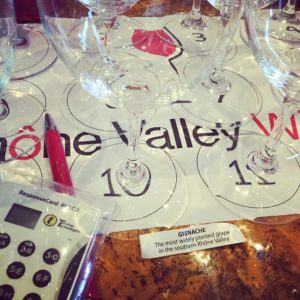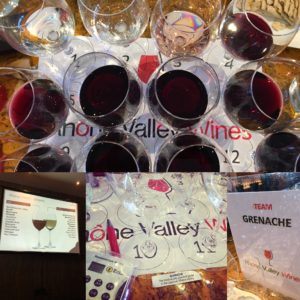By Leeann Froese
Do you know Rhône Valley wines?
It turns out, I know less than I thought.
Thankfully, at a trade event earlier in September at Vancouver’s Maenam restaurant, Michelle Bouffard, president of the local chapter of the Canadian Association of Professional Sommeliers (CAPS), hosted and presented a discovery workshop and tasting, to help bring some Rhône knowledge back to the forefront.
40 industry professionals: sommeliers, retailers, and media representatives alike, were joined by representatives of the Rhône Valley, Laure Vaissermann and Virginie Charlier, marketing and communication director of Inter-Rhône. Upon arrival to the event, each guest cracked open a fortune cookie, and inside was the name of one of five teams named after a few of the region’s famous varietals: Syrah, Grenache, Mourvèdre, Marsanne and Roussanne. Once randomly teamed up we tasted 12 wines from the Rhône Valley during a blind taste test. Our goal was to guess the appellations or varietals as part of an interactive challenge under the evocative theme “So you think you know Rhône?”
It turns out, I do not.
I was on Team Grenache, with notable trade #winelover -s including Noel Hollet, Rachel von Sturmer, Iain Philip, Ron Wilson, and Si Man Lee. I was impressed by the tasting ability and knowledge at my table, although the table discussion revealed that my team members, like me, were also not 100% confident.
Created from a range of 21 different varietals, Rhône Valley Wine wines are renowned for their depth and distinctiveness. The reds range from round and fruit forward, to full bodied and structured; the whites are floral and fruity or full bodied and deep, and there are dry rose wines as well, that range from fresh and bright to spicy.
It’s all about the blend; and while there are many varietals, for example, most blended reds are a combination of Syrah, Grenache and Mourvedre. The wines’ blends and flavour profiles depend on what area or village they are from and the related terroir, as well as the laws from each area as it relates to how much % of varietal is allowed in each blend.
Once we heard from Michelle about the regions, blends and laws, we blind tasted and were quizzed, with our answers submitted electronically and then displayed on a screen for all to see. I was not doing well at all, and my teammates were doing only slightly better.
I did OK on identifying the building blocks of the wines; identifying the acid, alcohol and tannin characteristics, but that is where my success ended…
Luckily the results were collected and posted by team, so no one saw that I only got a few of the questions right. I am sure that I brought my team’s score down, and here I publicly apologize to them!
Where I really fell down was aligning the wine characters to their origin. Related: I have a lot of dusting off of my WSET notes to do!
“Even seasoned experts can still learn something new about Rhône Valley Wines,” said Michelle Bouffard.
I wasn’t alone; there seemed to be collective groans in the room each time an answer was revealed. The fact that so many of us got responses incorrect provided a great chance to discuss why – for example why Ventoux in the foothills offers wines so different from the full-bodied and round Gigondas wines from further south.
Some other teams did much better, voting as a group and doing very well. Congratulations to Team Marsanne on earning bragging rights!
Bouffard adds “The region’s diverse appellations, soil types and flagship varietals make it a key wine region. What really turns heads are the wines’ versatility, as they pair wonderfully with a wide range of dishes, such as Maenam’s Asian specialties.”
After the tasting and quiz was done and the whole room seemed collectively deflated, our moods were revived by the chance to taste these wines again and openly discuss, this time knowing what we are reaching for, and also now accompanied by hand-passed bites from chef Angus An.
KEY STATISTICS ABOUT THE RHÔNE VALLEY WINES
- Ranks 2nd among French AOC vineyards in terms of volume;
- 388 million bottles sold in 2015;
- Over 50% of total production is certified organic;
- 1 bottle of Rhône Valley Wines AOC is enjoyed worldwide every 12 seconds;
- Over 10 years, the volume of Rhône Valley Wines exports to Canada has increased by 41%;
- In 2015, 11% (in volume) of French table wines in Canada is from Rhone Valley Wines. An overall 20% increase in BC sales of Rhone Valley Wines during 2015 to 2016.
Disclosure: As a member of CAPS BC, I was an invited guest at this event, and I thank Rhône Valley Wines for the chance to taste and learn. For more information on Rhône Valley Wines, visit www.vins-rhone.com




